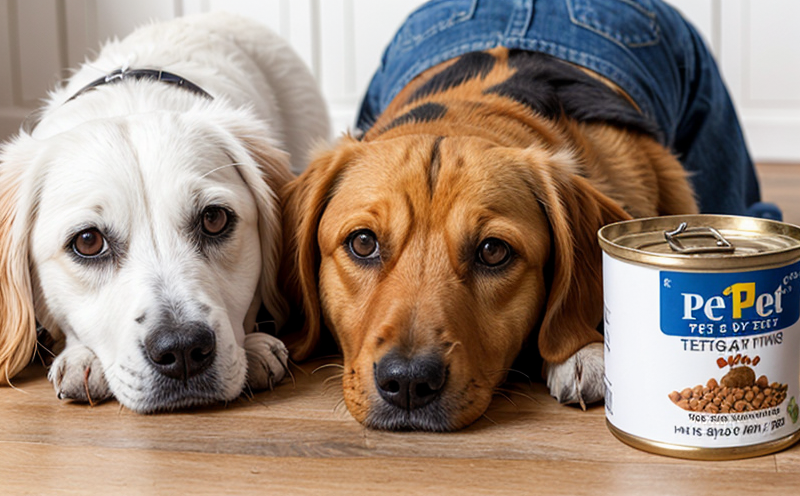ISO 64283 Lead Residue Testing in Pet Food Samples
The ISO 64283 standard provides a robust framework for quantifying lead residues in pet food samples. This standard is particularly important given the potential health risks associated with elevated levels of lead, especially for pets and animals that consume these products regularly.
Lead contamination can originate from various sources during the production process, including packaging materials, processing equipment, or environmental factors. The ISO 64283 protocol ensures accurate detection by leveraging state-of-the-art analytical techniques designed to minimize false positives while enhancing precision and sensitivity. This method is particularly critical for ensuring pet safety and compliance with international food safety regulations.
Compliance with this standard not only protects the health of pets but also enhances brand reputation among consumers who prioritize product quality and safety. By adhering to ISO 64283, manufacturers can demonstrate their commitment to responsible manufacturing practices and consumer trustworthiness.
The testing procedure involves several critical steps: sample preparation, digestion, and subsequent analysis using atomic absorption spectrophotometry (AAS) or inductively coupled plasma mass spectrometry (ICP-MS). These methods allow for precise quantification of lead levels down to parts per billion. The ISO 64283 protocol also specifies detailed quality control measures to ensure the reliability and accuracy of results.
Given the importance of this standard, we offer comprehensive testing services tailored specifically for pet food manufacturers and suppliers. Our team uses advanced laboratory equipment and adheres strictly to international standards, ensuring consistent and accurate results every time. This commitment to excellence aligns perfectly with our mission to provide reliable data that supports informed decision-making processes within your organization.
| Sample Type | Analytical Method | Limit of Detection (LOD) | Limit of Quantification (LOQ) |
|---|---|---|---|
| Powdered Pet Food | ICP-MS | 0.1 μg/g | 0.5 μg/g |
| Bulk Liquid Pet Food | AAS | 0.2 μg/L | 1.0 μg/L |
Why Choose This Test
- Ensures Compliance: Adherence to ISO standards is crucial for maintaining high-quality pet food products.
- Promotes Safety: Accurate identification of lead residues helps protect pets from potential health hazards.
- Enhances Reputation: Demonstrates a strong commitment to product quality and consumer safety.
- Achieves Consistency: Reliable results contribute to consistent product performance across batches.
- Supports Decision-Making: Provides valuable insights into supply chain integrity and operational efficiency.
Competitive Advantage and Market Impact
Becoming a leader in lead residue testing aligns your company with the global trend towards safer pet products. By offering ISO 64283 compliant services, you position yourself as a trusted partner for pet food manufacturers seeking to differentiate themselves through superior quality assurance practices.
Compliance with this standard can significantly impact market perception and drive sales growth. Consumers increasingly prioritize transparency regarding product safety measures when making purchasing decisions. Demonstrating compliance with internationally recognized standards like ISO 64283 signals that your company prioritizes both ethical business practices and consumer welfare.
In addition to enhancing brand reputation, achieving ISO certification can open doors to new markets or partnerships where stringent food safety regulations apply. It also allows businesses to stay ahead of regulatory changes by proactively addressing potential issues before they become compliance challenges.
Use Cases and Application Examples
- New Product Development: Testing during early stages ensures no harmful contaminants are present in innovative pet food formulations.
- Supplier Auditing: Regular checks on raw material suppliers help maintain consistent quality standards throughout the supply chain.
- Process Improvement: Identifying sources of contamination allows manufacturers to implement corrective actions promptly, preventing reoccurrence.
- Batch Verification: Post-production testing guarantees that all batches meet required safety criteria before release.
- Market Expansion: Compliance with international standards facilitates entry into new markets where stringent food safety regulations apply.
| Potential Risk | Mitigation Strategy |
|---|---|
| Lead Contamination from Packaging Materials | Use lead-free packaging solutions and conduct regular testing. |
| Inadequate Quality Control Measures | Implement stringent quality control protocols throughout the production process. |





